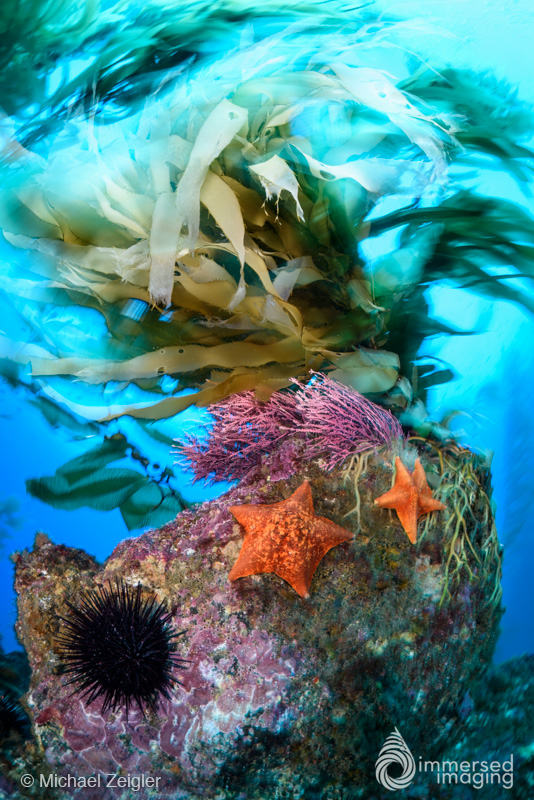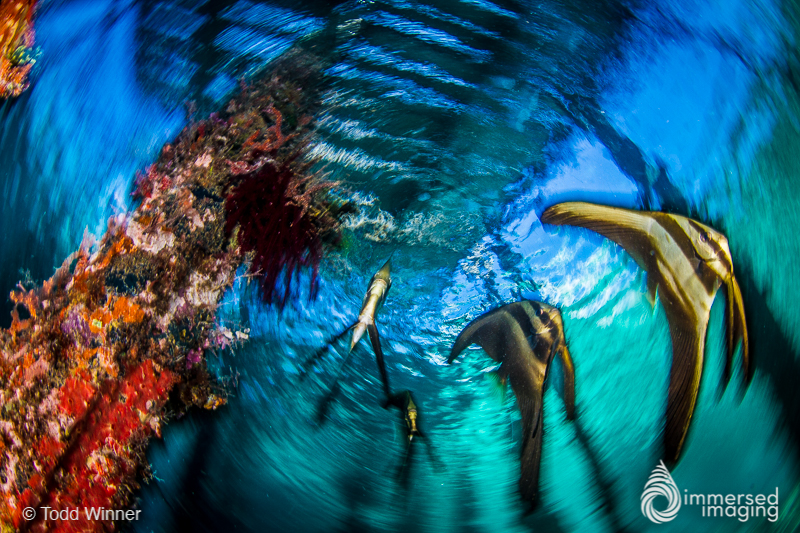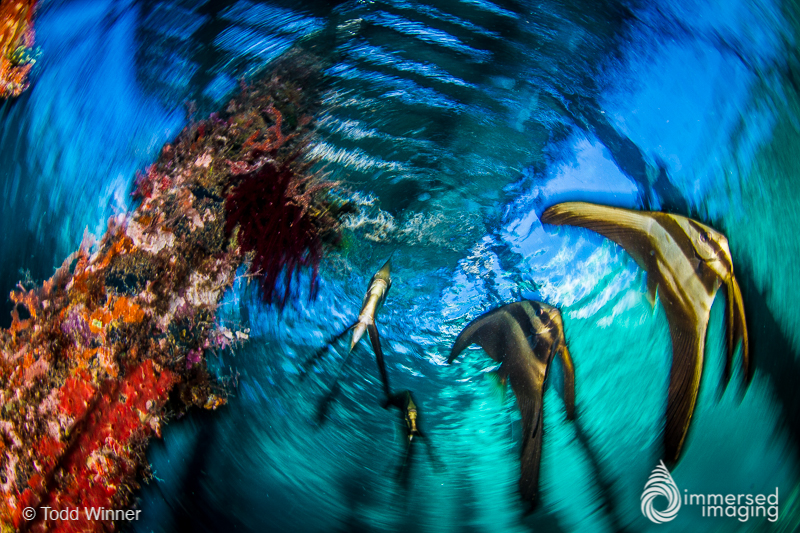Written by Michael Zeigler | Photos by Michael Zeigler and Todd Winner
 Dragging the shutter underwater can help produce images that convey a feeling of motion to the viewer. Strobe light allowed me to "freeze" the foreground subjects while the areas out of reach of the strobes were recorded on the sensor with the "slower" ambient light only. Nikon D810 in a Sea & Sea housing, Sigma 15mm FE lens, and dual Ikelite DS-160 strobes. 1/8 sec, ƒ/8, ISO 64.
The next time you find yourself in a creative slump, try this technique for a quick pick-me-up. Dragging the shutter is a term generally used to describe when you use a very slow sync speed with your flash, and it's a technique with which I have enjoyed experimenting over the past few years.
The Technique
The technique is really quite straight forward. In order to convey a sense of motion, especially with a wide-angle lens, a good starting point for your shutter speed would be 1/30 second. If your image will include ambient background light (especially when shooting wide-angle), you are going to want to start at base ISO (e.g. ISO 100). You will be letting in so much ambient light with the slower shutter speed (e.g. 1/30 sec), that you'll want your sensor to be less sensitive to light in order to keep the background exposure from blowing out. For this reason, I have found that this technique works best when lighting conditions are darker (e.g. early/late in the day or when it is cloudy).
Dragging the shutter underwater can help produce images that convey a feeling of motion to the viewer. Strobe light allowed me to "freeze" the foreground subjects while the areas out of reach of the strobes were recorded on the sensor with the "slower" ambient light only. Nikon D810 in a Sea & Sea housing, Sigma 15mm FE lens, and dual Ikelite DS-160 strobes. 1/8 sec, ƒ/8, ISO 64.
The next time you find yourself in a creative slump, try this technique for a quick pick-me-up. Dragging the shutter is a term generally used to describe when you use a very slow sync speed with your flash, and it's a technique with which I have enjoyed experimenting over the past few years.
The Technique
The technique is really quite straight forward. In order to convey a sense of motion, especially with a wide-angle lens, a good starting point for your shutter speed would be 1/30 second. If your image will include ambient background light (especially when shooting wide-angle), you are going to want to start at base ISO (e.g. ISO 100). You will be letting in so much ambient light with the slower shutter speed (e.g. 1/30 sec), that you'll want your sensor to be less sensitive to light in order to keep the background exposure from blowing out. For this reason, I have found that this technique works best when lighting conditions are darker (e.g. early/late in the day or when it is cloudy).
 Created later in the day, this image by Todd Winner involved spinning the camera while the shutter was being released. You may need to clamp down your strobe arms a bit when spinning the housing in order to keep them in position. Canon 7D in a Nauticam housing,Canon 8-15mm FE lens, and dual Ikelite DS-160 strobes. 1/15 sec, ƒ/11, ISO 100.
When including ambient light, your strobes will be competing against a lot of ambient light and a low ISO, and you will most likely find that your strobes will be at or near full power. You may need to open up your aperture a bit, and position your strobes closer to your port in order to achieve a proper foreground exposure.
Created later in the day, this image by Todd Winner involved spinning the camera while the shutter was being released. You may need to clamp down your strobe arms a bit when spinning the housing in order to keep them in position. Canon 7D in a Nauticam housing,Canon 8-15mm FE lens, and dual Ikelite DS-160 strobes. 1/15 sec, ƒ/11, ISO 100.
When including ambient light, your strobes will be competing against a lot of ambient light and a low ISO, and you will most likely find that your strobes will be at or near full power. You may need to open up your aperture a bit, and position your strobes closer to your port in order to achieve a proper foreground exposure.
 Dragging the shutter doesn't always have to include exposing for bright ambient light. This image was created on a safety stop in Grand Cayman, shooting straight down on this "bouquet" of yellow tube sponges. Nikon D7000 in a Sea & Sea housing, Tokina 10-17mm FE @ 13mm, and dual Ikelite DS-160 strobes. 1/30 sec, ƒ/8, ISO 100.[/caption]
For the image of the yellow sponges, I took several test frames while spinning the housing. I kept lowering the shutter speed until I achieved a nice blur of the sea floor. Once I decided on a shutter speed of 1/30 second, I spun the camera until the sponges were framed the way I wanted, and released the shutter (and fired the strobes). It helps to continue the spinning motion until after the shutter closes to ensure a nice, smooth recording of motion.
Dragging the shutter doesn't always have to include exposing for bright ambient light. This image was created on a safety stop in Grand Cayman, shooting straight down on this "bouquet" of yellow tube sponges. Nikon D7000 in a Sea & Sea housing, Tokina 10-17mm FE @ 13mm, and dual Ikelite DS-160 strobes. 1/30 sec, ƒ/8, ISO 100.[/caption]
For the image of the yellow sponges, I took several test frames while spinning the housing. I kept lowering the shutter speed until I achieved a nice blur of the sea floor. Once I decided on a shutter speed of 1/30 second, I spun the camera until the sponges were framed the way I wanted, and released the shutter (and fired the strobes). It helps to continue the spinning motion until after the shutter closes to ensure a nice, smooth recording of motion.
 Sea horse at the Solomon Islands. Nikon D2X with Nikon 60mm macro lens. 1/20 sec, ƒ/13, ISO 100.[/caption] Dragging the shutter can be fun with macro, too! The settings mentioned in this article are just recommended starting points, and experimenting with your settings is part of the creative process. Now ... just dial down the shutter speed and turn up the fun!
Sea horse at the Solomon Islands. Nikon D2X with Nikon 60mm macro lens. 1/20 sec, ƒ/13, ISO 100.[/caption] Dragging the shutter can be fun with macro, too! The settings mentioned in this article are just recommended starting points, and experimenting with your settings is part of the creative process. Now ... just dial down the shutter speed and turn up the fun!
 Juvenile garibaldi chasing each other around the reef. I used rear-curtain sync and held the camera steady as the playful fish swam through the frame. This technique helped to create the streaking of their bright blue markings. Nikon D7000 in a Sea & Sea housing, Nikon 105mm VR macro lens, and dual Ikelite DS-160 strobes. 1/10 sec, ƒ/22, ISO 100.
Juvenile garibaldi chasing each other around the reef. I used rear-curtain sync and held the camera steady as the playful fish swam through the frame. This technique helped to create the streaking of their bright blue markings. Nikon D7000 in a Sea & Sea housing, Nikon 105mm VR macro lens, and dual Ikelite DS-160 strobes. 1/10 sec, ƒ/22, ISO 100.
 Todd Winner is a contributor, instructor, and trip leader for Samy’s Underwater Photo & Video. He has over 20 years of experience in underwater still and broadcast video.
To see more of Todd’s work please go to www.toddwinner.com.
Todd Winner is a contributor, instructor, and trip leader for Samy’s Underwater Photo & Video. He has over 20 years of experience in underwater still and broadcast video.
To see more of Todd’s work please go to www.toddwinner.com.
 Michael Zeigler is a contributor, instructor, and trip leader forSamy’s Underwater Photo & Video as well as an AAUS Scientific Diver.
To see more of Micheal’s work please go to www.seainfocus.com
Michael Zeigler is a contributor, instructor, and trip leader forSamy’s Underwater Photo & Video as well as an AAUS Scientific Diver.
To see more of Micheal’s work please go to www.seainfocus.com
 Dragging the shutter underwater can help produce images that convey a feeling of motion to the viewer. Strobe light allowed me to "freeze" the foreground subjects while the areas out of reach of the strobes were recorded on the sensor with the "slower" ambient light only. Nikon D810 in a Sea & Sea housing, Sigma 15mm FE lens, and dual Ikelite DS-160 strobes. 1/8 sec, ƒ/8, ISO 64.
The next time you find yourself in a creative slump, try this technique for a quick pick-me-up. Dragging the shutter is a term generally used to describe when you use a very slow sync speed with your flash, and it's a technique with which I have enjoyed experimenting over the past few years.
The Technique
The technique is really quite straight forward. In order to convey a sense of motion, especially with a wide-angle lens, a good starting point for your shutter speed would be 1/30 second. If your image will include ambient background light (especially when shooting wide-angle), you are going to want to start at base ISO (e.g. ISO 100). You will be letting in so much ambient light with the slower shutter speed (e.g. 1/30 sec), that you'll want your sensor to be less sensitive to light in order to keep the background exposure from blowing out. For this reason, I have found that this technique works best when lighting conditions are darker (e.g. early/late in the day or when it is cloudy).
Dragging the shutter underwater can help produce images that convey a feeling of motion to the viewer. Strobe light allowed me to "freeze" the foreground subjects while the areas out of reach of the strobes were recorded on the sensor with the "slower" ambient light only. Nikon D810 in a Sea & Sea housing, Sigma 15mm FE lens, and dual Ikelite DS-160 strobes. 1/8 sec, ƒ/8, ISO 64.
The next time you find yourself in a creative slump, try this technique for a quick pick-me-up. Dragging the shutter is a term generally used to describe when you use a very slow sync speed with your flash, and it's a technique with which I have enjoyed experimenting over the past few years.
The Technique
The technique is really quite straight forward. In order to convey a sense of motion, especially with a wide-angle lens, a good starting point for your shutter speed would be 1/30 second. If your image will include ambient background light (especially when shooting wide-angle), you are going to want to start at base ISO (e.g. ISO 100). You will be letting in so much ambient light with the slower shutter speed (e.g. 1/30 sec), that you'll want your sensor to be less sensitive to light in order to keep the background exposure from blowing out. For this reason, I have found that this technique works best when lighting conditions are darker (e.g. early/late in the day or when it is cloudy).
 Created later in the day, this image by Todd Winner involved spinning the camera while the shutter was being released. You may need to clamp down your strobe arms a bit when spinning the housing in order to keep them in position. Canon 7D in a Nauticam housing,Canon 8-15mm FE lens, and dual Ikelite DS-160 strobes. 1/15 sec, ƒ/11, ISO 100.
When including ambient light, your strobes will be competing against a lot of ambient light and a low ISO, and you will most likely find that your strobes will be at or near full power. You may need to open up your aperture a bit, and position your strobes closer to your port in order to achieve a proper foreground exposure.
Created later in the day, this image by Todd Winner involved spinning the camera while the shutter was being released. You may need to clamp down your strobe arms a bit when spinning the housing in order to keep them in position. Canon 7D in a Nauticam housing,Canon 8-15mm FE lens, and dual Ikelite DS-160 strobes. 1/15 sec, ƒ/11, ISO 100.
When including ambient light, your strobes will be competing against a lot of ambient light and a low ISO, and you will most likely find that your strobes will be at or near full power. You may need to open up your aperture a bit, and position your strobes closer to your port in order to achieve a proper foreground exposure.
 Dragging the shutter doesn't always have to include exposing for bright ambient light. This image was created on a safety stop in Grand Cayman, shooting straight down on this "bouquet" of yellow tube sponges. Nikon D7000 in a Sea & Sea housing, Tokina 10-17mm FE @ 13mm, and dual Ikelite DS-160 strobes. 1/30 sec, ƒ/8, ISO 100.[/caption]
For the image of the yellow sponges, I took several test frames while spinning the housing. I kept lowering the shutter speed until I achieved a nice blur of the sea floor. Once I decided on a shutter speed of 1/30 second, I spun the camera until the sponges were framed the way I wanted, and released the shutter (and fired the strobes). It helps to continue the spinning motion until after the shutter closes to ensure a nice, smooth recording of motion.
Dragging the shutter doesn't always have to include exposing for bright ambient light. This image was created on a safety stop in Grand Cayman, shooting straight down on this "bouquet" of yellow tube sponges. Nikon D7000 in a Sea & Sea housing, Tokina 10-17mm FE @ 13mm, and dual Ikelite DS-160 strobes. 1/30 sec, ƒ/8, ISO 100.[/caption]
For the image of the yellow sponges, I took several test frames while spinning the housing. I kept lowering the shutter speed until I achieved a nice blur of the sea floor. Once I decided on a shutter speed of 1/30 second, I spun the camera until the sponges were framed the way I wanted, and released the shutter (and fired the strobes). It helps to continue the spinning motion until after the shutter closes to ensure a nice, smooth recording of motion.
 Sea horse at the Solomon Islands. Nikon D2X with Nikon 60mm macro lens. 1/20 sec, ƒ/13, ISO 100.[/caption] Dragging the shutter can be fun with macro, too! The settings mentioned in this article are just recommended starting points, and experimenting with your settings is part of the creative process. Now ... just dial down the shutter speed and turn up the fun!
Sea horse at the Solomon Islands. Nikon D2X with Nikon 60mm macro lens. 1/20 sec, ƒ/13, ISO 100.[/caption] Dragging the shutter can be fun with macro, too! The settings mentioned in this article are just recommended starting points, and experimenting with your settings is part of the creative process. Now ... just dial down the shutter speed and turn up the fun!
 Juvenile garibaldi chasing each other around the reef. I used rear-curtain sync and held the camera steady as the playful fish swam through the frame. This technique helped to create the streaking of their bright blue markings. Nikon D7000 in a Sea & Sea housing, Nikon 105mm VR macro lens, and dual Ikelite DS-160 strobes. 1/10 sec, ƒ/22, ISO 100.
Juvenile garibaldi chasing each other around the reef. I used rear-curtain sync and held the camera steady as the playful fish swam through the frame. This technique helped to create the streaking of their bright blue markings. Nikon D7000 in a Sea & Sea housing, Nikon 105mm VR macro lens, and dual Ikelite DS-160 strobes. 1/10 sec, ƒ/22, ISO 100.
 Todd Winner is a contributor, instructor, and trip leader for Samy’s Underwater Photo & Video. He has over 20 years of experience in underwater still and broadcast video.
To see more of Todd’s work please go to www.toddwinner.com.
Todd Winner is a contributor, instructor, and trip leader for Samy’s Underwater Photo & Video. He has over 20 years of experience in underwater still and broadcast video.
To see more of Todd’s work please go to www.toddwinner.com.
 Michael Zeigler is a contributor, instructor, and trip leader forSamy’s Underwater Photo & Video as well as an AAUS Scientific Diver.
To see more of Micheal’s work please go to www.seainfocus.com
Michael Zeigler is a contributor, instructor, and trip leader forSamy’s Underwater Photo & Video as well as an AAUS Scientific Diver.
To see more of Micheal’s work please go to www.seainfocus.com





